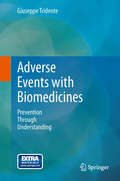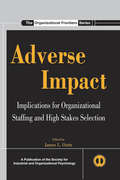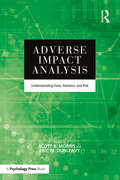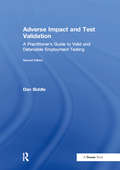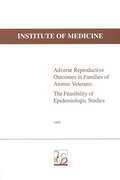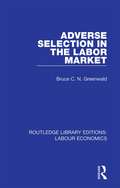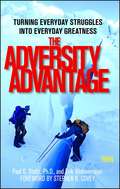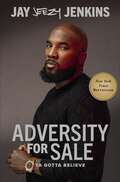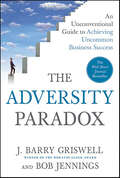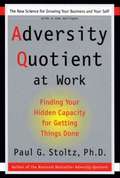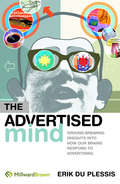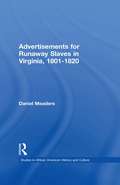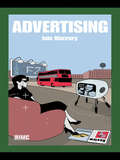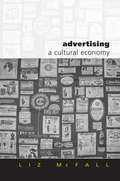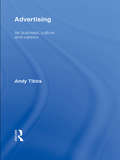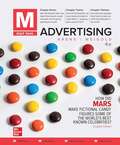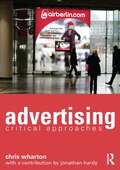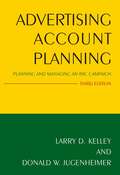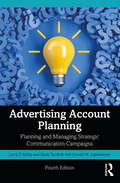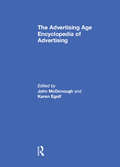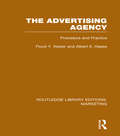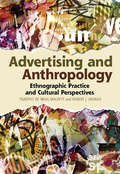- Table View
- List View
Adverse Events with Biomedicines: Prevention Through Understanding
by Giuseppe TridenteThis monograph gathers and evaluates data on adverse events (AEs) associated specifically with those "biomedicines" - monoclonal antibodies, fusion proteins, and cytokines - that have recently entered therapeutic use in humans. All AEs observed when using each member of this new drug class are covered, with a view to improving understanding of pathogenesis, facilitating prevention, monitoring, and control, and contributing to the development of better drugs that provide benefits while minimizing risk. Further aspects here examined include the role of drug mechanisms of action and immunogenicity in relation to AEs outcome and induction of systemic syndromes. Additional data on AEs in off-label treatments are also considered. Electronic data sheets, downloadable from Springer Extra Materials platform, include more detailed safety data as well as additional basic information on product characteristics, pre- and post-marketing AEs classified according to frequency, and system/organ targeting. Data on excipients and selected information on drug interactions and associations are also provided. Adverse Events with Biomedicines: Prevention Through Understanding will serve as a detailed, practical guideline to this important new area, which demands the attention of clinicians, immunologists, oncologists, allergologists, public health professionals, and drug companies.
Adverse Impact: Implications for Organizational Staffing and High Stakes Selection (SIOP Organizational Frontiers Series)
by James L. OuttzThis text is the best single repository for a comprehensive examination of the scientific research and practical issues associated with adverse impact. Adverse impact occurs when there is a significant difference in organizational outcomes to the disadvantage of one or more groups defined on the basis of demographic characteristics such as race, ethnicity, gender, age, religion, etc. This book shows, based on scientific research, how to design selection systems that minimize subgroup differences. The primary object of this volume in the SIOP series is to bring together renowned experts in this field to present their viewpoints and perspectives on what underlies adverse impact, where we are in terms of assessing it and what we may have learned (or not learned) about minimizing it.
Adverse Impact Analysis: Understanding Data, Statistics, and Risk
by Scott B. Morris Eric M. DunleavyCompliance with federal equal employment opportunity regulations, including civil rights laws and affirmative action requirements, requires collection and analysis of data on disparities in employment outcomes, often referred to as adverse impact. While most human resources (HR) practitioners are familiar with basic adverse impact analysis, the courts and regulatory agencies are increasingly relying on more sophisticated methods to assess disparities. Employment data are often complicated, and can include a broad array of employment actions (e.g., selection, pay, promotion, termination), as well as data that span multiple protected groups, settings, and points in time. In the era of "big data," the HR analyst often has access to larger and more complex data sets relevant to employment disparities. Consequently, an informed HR practitioner needs a richer understanding of the issues and methods for conducting disparity analyses. This book brings together the diverse literature on disparity analysis, spanning work from statistics, industrial/organizational psychology, human resource management, labor economics, and law, to provide a comprehensive and integrated summary of current best practices in the field. Throughout, the description of methods is grounded in the legal context and current trends in employment litigation and the practices of federal regulatory agencies. The book provides guidance on all phases of disparity analysis, including: How to structure diverse and complex employment data for disparity analysis How to conduct both basic and advanced statistical analyses on employment outcomes related to employee selection, promotion, compensation, termination, and other employment outcomes How to interpret results in terms of both practical and statistical significance Common practical challenges and pitfalls in disparity analysis and strategies to deal with these issues
Adverse Impact Analysis: Understanding Data, Statistics, and Risk
by Scott B. Morris Eric M. DunleavyCompliance with federal equal employment opportunity regulations, including civil rights laws and affirmative action requirements, requires collection and analysis of data on disparities in employment outcomes, often referred to as adverse impact. While most human resources (HR) practitioners are familiar with basic adverse impact analysis, the courts and regulatory agencies are increasingly relying on more sophisticated methods to assess disparities. Employment data are often complicated, and can include a broad array of employment actions (e.g., selection, pay, promotion, termination), as well as data that span multiple protected groups, settings, and points in time. In the era of "big data," the HR analyst often has access to larger and more complex data sets relevant to employment disparities. Consequently, an informed HR practitioner needs a richer understanding of the issues and methods for conducting disparity analyses.This book brings together the diverse literature on disparity analysis, spanning work from statistics, industrial/organizational psychology, human resource management, labor economics, and law, to provide a comprehensive and integrated summary of current best practices in the field. Throughout, the description of methods is grounded in the legal context and current trends in employment litigation and the practices of federal regulatory agencies. The book provides guidance on all phases of disparity analysis, including: How to structure diverse and complex employment data for disparity analysis How to conduct both basic and advanced statistical analyses on employment outcomes related to employee selection, promotion, compensation, termination, and other employment outcomes How to interpret results in terms of both practical and statistical significance Common practical challenges and pitfalls in disparity analysis and strategies to deal with these issues
Adverse Impact and Test Validation: A Practitioner's Guide to Valid and Defensible Employment Testing
by Dan BiddleAdverse impact analyses and test validation promote social justice and equity. Employers who unknowingly use invalid tests or recruitment procedures that have an adverse impact are reducing minority and/or female representation in their workforce, unfairly screening out qualified workers and (worst of all) just plain discriminating. Dan Biddle's Adverse Impact and Test Validation provides you with analyses that allow you to identify which of your selection procedures have adverse impact. The validation steps will help you decide whether to keep the selection procedure (because it's valid), change it, or stop using it altogether. This second edition contains new material on using multiple regression to evaluate pay practices and provides step-by-step instructions for using SPSS or Excel for evaluating your company's pay practices for possible inequities. New content on how to define "Internet applicants" and set up defensible Basic Qualifications (BQs) for online recruiting will help employers ensure compliance with EEO regulations and screen in qualified applicants. Specific guidelines for developing and validating written job knowledge tests, such as those used for police and fire promotional testing, have also been included in this new edition. The CD included in the back cover of the book includes tools (which may be used on a trial evaluation basis) describing several of the functions described in the book, including Adverse Impact Toolkit®, Test Validation and Analysis Program® (TVAP®), Guidelines Oriented Job Analysis® (GOJA®) Manual, and Content Validity Checklists. This highly pragmatic guide goes beyond the concepts, theories and ideas behind adverse impact and test validation. It not only explains what to do but crucially, also shows you how to do it. The second edition has been expanded to include two brand new chapters with a new Appendix and comes with new editions of the accompanying software. As a means of protecting your organization from litigation, damage to employee relations and to your corporate reputation, Adverse Impact and Test Validation is a 'must-have' purchase for human resource professionals, testing and recruitment specialists.
Adverse Reproductive Outcomes in Families of Atomic Veterans: The Feasibility of Epidemiologic Studies
by National Research CouncilOver the past several decades, public concern over exposure to ionizing radiation has increased. This concern has manifested itself in different ways depending on the perception of risk to different individuals and different groups and the circumstances of their exposure. One such group are those U.S. servicemen (the "Atomic Veterans" who participated in the atmospheric testing of nuclear weapons at the Nevada Test Site or in the Pacific Proving Grounds, who served with occupation forces in or near Hiroshima and Nagasaki, or who were prisoners of war in or near those cities at the time of, or shortly after, the atomic bombings. This book addresses the feasibility of conducting an epidemiologic study to determine if there is an increased risk of adverse reproductive outcomes in the spouses, children, and grandchildren of the Atomic Veterans.
Adverse Selection in the Labor Market (Routledge Library Editions: Labour Economics #7)
by Bruce C. GreenwaldFirst published in 1979. This thesis describes the theoretical impact on labour markets of a process of adverse selection similar to that described in outline by George Arthur Akerlof. It concerns the information conveyed to potential employers by the fact that any new worker, except for one just entering the labour force, has either left or is prepared to leave his latest Job. If an employer is able to identify his good workers more accurately than the market at large and is generally successful in retaining them, then the group of workers leaving him will contain a disproportionately small number of good ones. For similar reasons this pool should also contain an unusually large number of bad workers who have been either flied or induced to quit. Thus, workers who change jobs should on average be less able ones. Since the market failures that result have potentially significant consequences in the labour market, this study is devoted to examining their influence on the structure of wages and job tenure, and on the operation and efficiency of labour markets. This title will be of great interest to students of economics and business studies.
The Adversity Advantage: Turning Everyday Struggles into Everyday Greatness
by Erik Weihenmayer Paul StoltzFrom the world’s foremost blind athlete and a Harvard Business School lecturer comes an inspiring, seven-step program for converting both mundane and dramatic struggles into the kind of fuel that spur personal and professional greatness.Adversity is one of the most potent forces in life. It shapes your character, clarifies your priorities, and defines your path. It can also fuel your greatness. Each of us faces a rich assortment of adversities every day, ranging from minor hassles to major setbacks and challenges, even tragedies. Nobody knows this better than blind adventurer Erik Weihenmayer and adversity expert Dr. Paul Stolz. In this exciting new edition of The Adversity Advantage, this dream-team joined forces to offer incredible experiences and practical science to teach you how to turn life challenges into a powerful advantage. Weihenmayer, who is the only blind person to climb Mount Everest and the Seven Summits, shares his struggles on high mountains to turn adversity on its head and do the impossible. Coauthor Stoltz has spent decades decoding the human relationship with adversity and is the creator of the globally acclaimed Adversity Quotient. Fully revised and updated, this new edition of The Adversity Advantage offers lessons from real-life adventure, seemingly insurmountable challenges, and extensive research to help you achieve greatness. This unique book provides an exciting and insightful framework for surpassing obstacles and reaching higher goals. Its seven proven principles will help you harness the adversity in your life and turn it into agility, innovation, energy, and happiness: · Take it on!· Summon your strength· Engage your core· Pioneer possibilities· Pack light, pack right· Suffer well· Deliver greatness, every day Let The Adversity Advantage inspire you to overcome obstacles, no matter how daunting!
Adversity for Sale: Ya Gotta Believe
by JeezyTo Jeezy&’s legion of fans, his name is synonymous with hustle, grit, and the integrity to go out there and achieve your dreams. In his first book, Adversity for Sale: Ya Gotta Believe, Jeezy shares never heard stories of what it took for him to beat the odds and get out of the streets, his mindset he carefully honed to get an edge, and the lessons that changed his life and business.Born into poverty and raised in a small town in the middle of South Georgia&’s so-called &“Black belt,&” Jeezy realized at an early age that nothing was going to come easy, there were no handouts headed his way, and if he ever wanted anything in life, he was going to have to get out there and get it on his own. So that&’s what he did. Now, for the first time, Jeezy retraces his steps, going back to day one to share how he turned nothing into something, stayed solid, survived the trap, and triumphed over adversity to become the successful artist, father, husband, entrepreneur, and philanthropist that he is today. Adversity for Sale isn&’t a street memoir. Like his music, these pages are filled with lessons from his deeply personal story to motivate you to go out and get after your dream.
The Adversity Paradox: An Unconventional Guide to Achieving Uncommon Business Success
by J. Barry Griswell Bob JenningsHarvey Mackay, Doris Christopher, Pete Dawkins, Clay Jones and John Pappajohn know that the answer to how you recover from career toppling adversity, and then go on to achieve pinnacles of success lies in firsthand knowledge of "the adversity paradox". They all attest to having found that the knowledge they gained from overcoming adversity played such a crucial role in their success trajectories, they now consider adversity a friend. While many motivational business books promise easy access to prosperity and power by way of secret insight, quick and easy steps, or "insider tips" that are dubious at best, The Adversity Paradox tells it straight and offers no secret formula or silver bullet; instead it offers candid accounts from those whose skills, resourcefulness, and confidence have been tested by adversity and who have put their misfortunes to good use by gaining invaluable business lessons from them. The paths to success are diverse, but The Adversity Paradox identifies patterns that anyone can study and learn from. Business people working to overcome humble beginnings, lack of knowledge, unexpected setbacks, or any manner of misfortune may find the greatest tool for creating business success lies in this new book.
Adversity Quotient at Work: Finding Your Hidden Capacity for Getting Things Done
by Paul G. StoltzIn 1997, Paul Stoltz unleashed a revolution with his groundbreaking book Adversity Quotient: Turning Obstacles into Opportunities, introducing the concept of the Adversity Quotient into public consciousness. Now, in Adversity Quotient @ Work, Stoltz applies the principles of his brilliant theory to the uniquely challenging environment of the workplace.AQ is a measure of one's ability to handle adversity. Those who can't become easily overwhelmed and emotional, then pull back and stop trying; those who can handle adversity become the leaders of today and tomorrow. Adversity Quotient @ Work clearly demonstrates how workers and managers can use this concept of the AQ to their own advantage, and to the benefit of their clients and customers.Adversity Quotient @ Work teaches listeners how to hire and retain highly motivated and talented workers, develop employees to their full potential, and create a leadership culture that encourages all to put forth their best efforts and maximize their performance capabilities. Based on real research performed with thousands of managers and members of the workforce on the front lines of hundreds of businesses, it will quickly become any corporation's indispensable handbook for success.
The Advertised Mind: Groundbreaking Insights into How Our Brains Respond to Advertising
by Erik Du PlessisAdvertising research organizations have been trying for years to measure the effectiveness of advertising.The Advertised Mind draws on the very latest research into the workings of the human brain undertaken by psychologists, neurologists and artificial intelligence specialists. Author Erik du Plessis uses this research to suggest why emotion is such an important factor in establishing a firm memory of an advertisement and predisposing consumers to buy the brand that is being advertised.He also draws on the findings of Adtrack's world-famous database of responses to over 30,000 TV commercials (the largest in the world). He explores what "ad-liking" really means, and suggests how this paradigm about the role of emotion has resulted in a continued effort to obtain maximum return from advertising spend.
Advertisements for Runaway Slaves in Virginia, 1801-1820 (Studies in African American History and Culture)
by Daniel MeadersFirst published in 1997. Routledge is an imprint of Taylor & Francis, an informa company.
Advertising: Advertising Vol. Iv (Routledge Introductions To Media And Communications Ser.)
by Iain MacRuryAdvertising, once seen as 'the official art of capitalist society' is an increasingly commonplace component of a characteristically promotional culture. Iain MacRury's Advertising offers the means to explore and evaluate this transition with an introduction to advertising for the contemporary reader.Advertising provides a clear and easy guide to a
Advertising: A Cultural Economy (Culture, Representation and Identity series)
by Liz McfallAdvertising is often used to illustrate popular and academic debates about cultural and economic life. This book reviews cultural and sociological approaches to advertising and, using historical evidence, demonstrates that a rethink of the analysis of advertising is long overdue. Liz McFall surveys dominant and problematic tendencies within the current discourse. This book offers a thorough review of the literature and also introduces fresh empirical evidence. Advertising: A Cultural Economy uses a historical study of advertising to regain a sense of how it has been patterned, not by the `epoch', but by the interaction of institutional, organisational and technological forces.
Advertising: Its Business, Culture and Careers
by Andy Tibbs‘A no-holds-barred overview of the very competitive but ultimately rewarding industry that is advertising. Insightful, well-informed, frank and honest. An inspirational eye-opener for all Adland wannabes’ – Gyles Lingwood, Course Leader, Creative Advertising, University of Lincoln, UK 'Like the advertising business, Tibbs' book is dynamic, edgy, and challenging. It captures the industry's excitement, energy, intellect, and creativity. The book is an inspiration and should be standard reading for all practitioners, students, and faculty of advertising, marketing, and communications'– Pamela Morris, Loyola University Chicago, USA ‘Tibbs’ insights turn the advertising agency from a mythical wonderland to a realistic career choice. Through reading this book and taking note of his advice, students will be one step closer to walking through its doors’ – Helen Powell, Senior Lecturer, Media and Advertising, University of East London, UK Advertising does not need another graduate! Whether you are an aspiring advertising creative, designer, account manager, PR / publicity consultant or marketing manager, Advertising is an engaging source of inspiration for those dark, idea-less days and a motivator when those job interviews or placements seem in short supply. Its Companion Website at: www.routledge.com/textbooks/advertising supports the book with further examples and ideas to inspire as well as offering up-to-date advice. This book is filled with numerous visual examples of advertising thinking. With words of advice and guidance from some of the industry’s most respected practitioners and insights from graduates who faced the same challenges you will soon encounter in securing that elusive first job. Add to that, an extensive supply of hints and tips to enhance the creative thinking processes, take the work you do beyond what you think you are capable of and, crucially, gain an edge at job interviews. Maybe advertising doesn’t need another graduate, but then you won’t be just another graduate will you?
Advertising
by Michael VazIn This books you can learn about Advertising in excting area of marketing .
Advertising
by Michael F. Weigold William F. ArensM: Advertising examines advertising from the perspective of the advertiser as well as the specialists who create advertising. M: Advertising takes students beyond theory to learn about roles within each of these organizations, and to consider which they might one day play themselves in a highly visual, condensed, engaging format. Supported by a robust digital Connect Advertising offer, M is relevant, engaging, and cost-effective for today’s business students.
Advertising: Critical Approaches
by Chris WhartonAdvertising: Critical Approaches explores a broad range of critical theories and perspectives to shed new light on the organisation, workings and effects of the advertising industry today. Chris Wharton presents the social, cultural and economic role of advertising across history, with chapters tracking the process of advertising from production to reception. Split into three sections covering Foundations, Frameworks and Applications, the book’s chapters explore a range of areas central to an insight into the development of modern advertising, including: advertising history cultural, critical and political economy approaches to advertising texts in advertising the reception of advertising advertising in the home and outdoor advertising consumer culture. Case studies explore the diversity in the uses of advertising throughout history, from Ostia and the Square of the Corporations in the ancient Roman world to the UK Border Agency’s ‘Go Home’ campaign and contemporary City branding throughout Europe. Assessing the impact of the works of key critical thinkers including Marx, Morris, Lyotard, Barthes, Saussure, Williams and Hall have had on our understanding of consumption and advertising’s societal impact, Advertising: Critical Approaches illuminates and enhances our understanding and engagement with one of the most vital cultural and economic forces in contemporary society.
Advertising Account Planning: Planning and Managing an IMC Campaign
by Larry Kelley Donald W. JugenheimerConcise yet comprehensive, this practical guide covers the critical role of the account planner in advertising. The new edition of Advertising Account Planning features several new topics as well as deeper content in existing areas based on feedback from students, instructors and practitioners.
Advertising Account Planning: Planning and Managing Strategic Communication Campaigns
by Sarah Turnbull Larry Kelley Donald JugenheimerThis practical and comprehensive text effectively provides advertising account planning principles within an integrated marketing communications framework. With a world-renowned textbook author team, this 4th edition has been fully updated to include: Fresh professional examples and mini-case studies within each chapter with a more global outlook than previous editions, bringing the theoretical concepts to life A new chapter on International Advertising addressing the challenges of managing a global campaign Pedagogical features and visual aids to support student learning and comprehension, including reflective questions and mini-cases drawn from current industry examples New and expanded content covering digital marketing and technologies; the customer journey; ethics and corporate social responsibility; global positioning of the brand; paid, earned and owned media; influencer marketing, and campaign measurement and analytics. Providing a full understanding of the advertising account planning process, this textbook is perfect for both the industry and classroom. The textbook will equip students of Marketing Communications, Advertising Management and Brand Management with the knowledge and skills they need to plan and manage a strategic communications campaign, including prominent advertising student competitions such as American Advertising Federation ( AAF) National Student Advertising Competition ( NSAC) or the Collegiate EFFIES. Online resources include PowerPoint slides and a test bank.
The Advertising Age Encyclopedia of Advertising
by John McDonough Karen EgolfFor a full list of entries and contributors, a generous selection of sample entries, and more, visit the The "Advertising Age" Encyclopedia of Advertising website.Featuring nearly 600 extensively illustrated entries, The Advertising Age Encyclopedia of Advertising provides detailed historic surveys of the world's leading agencies and major advertisers, as well as brand and market histories; it also profiles the influential men and women in advertising, overviews advertising in the major countries of the world, covers important issues affecting the field, and discusses the key aspects of methodology, practice, strategy, and theory. Also includes a color insert.
The Advertising Agency: Procedure and Practice (Routledge Library Editions: Marketing)
by Floyd Keeler Albert HaaseThis book discusses the challenges of running an advertising agency in the early part of the twentieth century and examines the organization and operation of such agencies in great detail. One of the earliest "manuals" on planning and operating an advertising agency, this book was also one of the first to illustrate the vital part that advertising plays in the successful business, using six American advertising agencies as its sources.
Advertising and Anthropology: Ethnographic Practice and Cultural Perspectives
by Robert J. Morais Timothy de Waal MalefytExamining theory and practice, Advertising and Anthropology is a lively and important contribution to the study of organizational culture, consumption practices, marketing to consumers and the production of creativity in corporate settings. The chapters reflect the authors' extensive lived experienced as professionals in the advertising business and marketing research industry. Essays analyze internal agency and client meetings, competitive pressures and professional relationships and include multiple case studies. The authors describe the structure, function and process of advertising agency work, the mediation and formation of creativity, the centrality of human interactions in agency work, the production of consumer insights and industry ethics. Throughout the book, the authors offer concrete advice for practitioners.Advertising and Anthropology is written by anthropologists for anthropologists as well as students and scholars interested in advertising and related industries such as marketing, marketing research and design.
